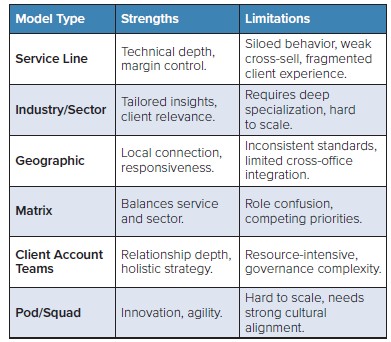Growth Perspectives | Fall 2025
The Key to Cross-Selling CPA Services? Being Client Centric
To successfully serve clients with multidisciplinary solutions, firms must deliver value the way clients want to experience it—at the center.

Brian Blaha, CPA
Managing Director, Winding River Consulting
Strategic Insights for Today’s Firm Leaders
Cross-selling has been one of the most persistent barriers to growth in certified public accounting (CPA) and advisory firms—particularly as firms invest more heavily in advisory services.
Over the years, we’ve seen a range of tactics used to crack the code: service line spotlights, internal training, customer relationship management (CRM) implementations, gamification, and a mix of incentive programs. Some show flashes of success, but for most firms, the results are temporary. That’s because the cross-sell challenge isn’t simply about tools or tactics—it’s structural, cultural, and personal.
To make progress, we must stop asking how we can better cross-sell and instead ask, “What would have to be true about our structure to holistically serve the client?”
WHAT DOES IT TAKE TO BE TRULY CLIENT CENTRIC?
Serving clients with multidisciplinary solutions requires a shift that affects every aspect of a firm’s design and mindset—you have to flip your perspective from what services you sell to what problems you can solve.
To be a truly client-centric firm, these are the foundational characteristics you need to adopt:
- Client-centric orientation: You’ll need to see the full picture of the client’s business. In every conversation, it should be 80% listening to your client and 20% talking to your client—let curiosity drive the relationship.
- Clear roles and processes: Define how client teams work together across departments. Ensure every team member knows their role and how they support the broader client relationship.
- Firmwide mindset shift: Clients don’t belong to a partner or service line—they belong to the firm. Every interaction is an opportunity to steward that relationship together.
- Cross-functional trust: Trust must extend beyond service lines. Collaboration is only possible when credibility is shared and accountability is mutual.
- Enablement through knowledge: Cross training must become part of your firm’s DNA. People can’t connect clients to other parts of the firm if they don’t understand them.
- Aligned systems and incentives: CRM systems must enable shared planning, not siloed activity. Additionally, incentives should reinforce collaboration and client-centric behavior, not protect turf.
- One-firm experience: Regardless of who’s delivering the work, the client experience should feel unified. It’s important to remember that consistency in delivery strengthens brand trust and deepens loyalty.
WHAT STRUCTURAL MODELS SUPPORT CLIENT CENTRICITY?
Most firms still organize primarily by service line. From an internal lens, it makes sense. It’s how we manage delivery, develop technical talent, and track financial performance. But from the client’s perspective, it creates disjointed experiences, missed opportunities, and stunted growth. Service line structures foster siloed thinking—and that’s where cross-selling dies.
In many firms, the relationship executive (RE) is assigned based on the first service delivered. For example, if the first engagement is an audit, the RE is an auditor. If it’s a valuation, the RE is an advisor. The problem with this approach is that the initial service provided to a client often dictates the lens through which they see the entire firm. As one CPA firm partner said bluntly, “We’re great at selling additional services within our department—not across them.”
To solve this, firms need to shift their mindsets from selling services to solving problems and back it up with structural change.
So, what structural models best support client centricity? I believe most CPA and advisory firms would benefit from a hybrid approach, using a combination of the common models shown in the chart below. Typically, combining service line infrastructure with either industry specialization or client account teams works best.
This dual-accountability model gives you the best of both worlds: depth of technical expertise and breadth needed to understand and address the client’s full business needs. It also aligns with how clients think—holistically, not functionally.

BEGINNING THE SHIFT TO CLIENT-CENTRIC TEAMS
Client-centric delivery starts with how we form and manage client teams. For instance, many progressive firms are now adding client success managers (CSM)—often from customer service or account management backgrounds—and making them the first point of contact. The CSM partners with the RE to manage the overall relationship, ensure coordination across service lines, and build connection with the client’s full leadership team.
These teams also include engagement managers from each active service line, plus any associates working on the account. Ideally, many of these professionals will bring industry expertise to their roles—which will become more scalable the more narrowly a firm defines its niche.
This structure is especially effective when wrapped within an industry segmentation strategy. It reinforces the relevance of the firm’s advice, deepens relationships across client stakeholders, and increases the likelihood of multidisciplinary expansion.
To begin shifting to a client-centric firm, consider these five actions:
- Audit your current organizational design through a client lens: Map how a client actually experiences your firm across services. Where are the handoffs choppy? Where’s value being lost?
- Define clear roles for relationship and delivery management: Separate who owns the relationship from who delivers the work. Consider adding CSMs to orchestrate delivery.
- Align incentives to shared success: Review compensation plans, bonus structures, and promotion criteria. Do they encourage firm-first thinking or service line protectionism?
- Build cross-functional client teams: Assemble teams with defined roles across service lines and industry expertise. Hold joint planning sessions and account reviews.
- Develop a one-firm training and enablement program: Invest in cross-education to ensure every team member can identify client needs beyond their specialty and know how to act on them.
Remember, cross-selling isn’t a campaign—it’s an outcome. It’s a byproduct of aligning your firm to deliver value the way clients want to experience it. If your organizational chart makes sense internally but breaks down at the client level, it’s time to rethink it.
Delivering multidisciplinary services starts not with a sales push but with a design principle. First, organize around the client, not the service. From there, every system—roles, incentives, technology, and governance—must reinforce that model.
Ultimately, the firms that’ll thrive in this new era are those bold enough to reimagine how they operate—with the client at the center, not the margins.
Related Content: